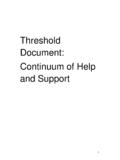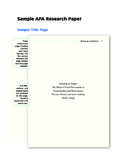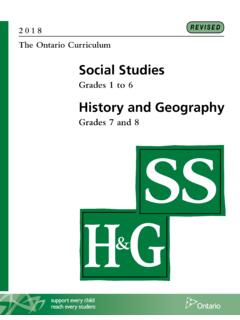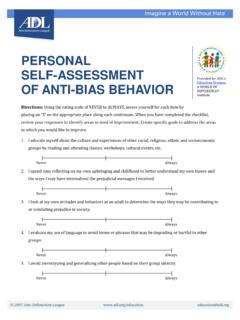Transcription of INSTRUCTIONAL MODELS AND STRATEGIES FOR …
1 INSTRUCTIONAL MODELS AND. STRATEGIES FOR TEACHING. ENGLISH LANGUAGE LEARNERS. INSTRUCTIONAL MODELS AND. STRATEGIES FOR TEACHING. ENGLISH LANGUAGE LEARNERS. Ani C. Moughamian Mabel O. Rivera David J. Francis Texas Institute for Measurement, Evaluation, and Statistics University of Houston The authors acknowledge the valuable assistance given by reviewers Nonie Lesaux, Charlene Rivera, Marjorie Rosenberg, Maria Helena Malagon, and Robert Rueda, and by Angela Penfold and Elizabeth Goldman of the Center on Instruction. This publication was created for the Center on Instruction by the Texas Institute for Measurement, Evaluation, and Statistics at the University of Houston. The Center on Instruction is operated by RMC Research Corporation in partnership with the Florida Center for Reading Research at Florida State University; INSTRUCTIONAL Research Group; the Texas Institute for Measurement, Evaluation, and Statistics at the University of Houston; and The Meadows Center for Preventing Educational Risk at The University of Texas at Austin.
2 Editorial, design, and production services provided by RMC. Research Corporation. Preferred citation: Moughamian, A. C., Rivera, M. O., & Francis, D. J. (2009). INSTRUCTIONAL MODELS and STRATEGIES for teaching English language learners. Portsmouth, NH: RMC Research Corporation, Center on Instruction. The Center on Instruction and the U. S. Department of Education retain sole copyright and ownership of this product. However, the product may be downloaded for free from the Center's website. It may also be reproduced and distributed with two stipulations: (1) the preferred citation, noted on this page, must be included in all reproductions and (2) no profit may be made in the reproduction and/or distribution of the material. Nominal charges to cover printing, photocopying, or mailing are allowed. Copyright 2009 by the Center on Instruction at RMC. Research Corporation To download a copy of this document, visit CONTENTS.
3 1 INTRODUCTION. 2 Contextual factors 3 Definitions 3 Language vs. quality of instruction 4 Guiding questions 5 INSTRUCTIONAL MODELS AND PROGRAMS. 6 English-only model 6 Structured immersion programs 6 Sheltered instruction programs 7 Bilingual model 7 Dual language programs 7 Transitional bilingual programs 9 RESEARCH ON LANGUAGE OF INSTRUCTION. 11 INSTRUCTIONAL METHODS AND STRATEGIES . 12 The CALLA cycle of instruction 13 English-only STRATEGIES 13 Sheltered Instruction Observation Protocol (SIOP). 14 Specially Designed Academic Instruction in English (SDAIE). 15 Dual language STRATEGIES 15 Bilingual Cooperative Integrated Reading and Composition (BCIRC). 16 Improving Literacy Transitional INSTRUCTIONAL Program (ILTIP). 20 IMPLICATIONS AND RECOMMENDATIONS. 23 REFERENCES. 29 APPENDIX A: INSTRUCTIONAL METHODS AND STRATEGIES . 32 APPENDIX B: BILINGUAL COOPERATIVE INTEGRATED READING AND. COMPOSITION (BCIRC) ACTIVITIES.
4 INTRODUCTION. Students identified as limited English proficient (LEP), also known in the literature and in educational settings as English language learners (ELLs), represent one of the fastest growing groups among the school-aged population in the Estimates place the ELL population at nearly 10 million students, increasing at a rate of more than 169% from 1979 to 2003 (NCES, 2004). Current projections place the proportion of English language learners at nearly 30% of the school population by 2015 (Capps et al., 2005). English language learners speak more than 400 different languages. Spanish, spoken by some 70 percent of ELLs, is the most common of these languages. With growing numbers of English language learners, states and schools face pressure to ensure that INSTRUCTIONAL practices for English language learners are effective and that these students make significant academic progress each year.
5 Students who have limited English proficiency receive school support under key provisions of the No Child Left Behind (NCLB) Act of 2001 ( Department of Education, 2002), which holds state education agencies accountable for the progress of ELLs in two ways. ELLs must meet Adequate Yearly Progress expectations for reading and mathematics under Title I and Annual Measurable Year Objectives under Title III. English language learners must demonstrate satisfactory progress in learning English and in attaining English proficiency on standardized content and language assessment instruments. While some states (Arizona, California, Florida, and Massachusetts) have passed laws detailing the types of educational programs available to English language learners, others have not. Teachers who have not been trained to work with ELLs must make decisions about the types of INSTRUCTIONAL programs and STRATEGIES they will offer these students.
6 This publication seeks to offer educators and policy-makers guidance on STRATEGIES that have been effective in instructing English language learners. We begin by outlining key contextual factors that decision-makers should take into account when making INSTRUCTIONAL choices for English language learners, then follow with a brief overview of bilingual and English-only INSTRUCTIONAL MODELS . Finally, we consider the influence of the language of instruction on academic outcomes for English language learners. Regardless 1. of the model that school districts select, teachers must use the most effective STRATEGIES to accelerate student learning and maximize INSTRUCTIONAL time; this publication suggests research-based INSTRUCTIONAL STRATEGIES appropriate for a range of ELL INSTRUCTIONAL MODELS . Contextual factors Many factors make it difficult to develop a one size fits all model of instruction for this diverse group of students.
7 The characteristics and dynamics of the student population, classroom, school, and community all affect appropriate program selection. Available empirical evidence and how it relates to these variables should be considered when choosing and adjusting an INSTRUCTIONAL program (along with additional STRATEGIES , MODELS , or INSTRUCTIONAL tools used in the classroom). Contextual factors that may affect these decisions fall within three main categories: (a) child and family characteristics; (b). INSTRUCTIONAL program features; and (c) socio-political and cultural considerations. Child and family factors include a student's language knowledge (his or her native language as well as English proficiency), socio-economic status (SES), acculturation into American society, the culture of American public school, age1 of arrival, and immigration status (first or second generation). Some students have developed literacy in their native language when they begin instruction in English; others have not.
8 Each factor affects academic outcomes independently and also interacts with the others in complex ways to affect academic performance. INSTRUCTIONAL program features vary, as do the fidelity of program implementation and teacher quality. All influence the effectiveness of any program. Socio-political and cultural considerations color the debates about appropriate instruction. State and federal laws and beliefs about citizenship, immigration, and poverty complicate and influence INSTRUCTIONAL decision-making. In Pacific states, for example, English may be a second or third language. At the same time, English-only states determine the types of INSTRUCTIONAL programs schools may implement for English language learners. 1 Students who arrive in the with little or no previous schooling may be placed in newcomer programs. However, newcomer programs are not the focus of the current document. Rather, we focus here on the language of instruction and the use of INSTRUCTIONAL STRATEGIES in different program MODELS of instruction.
9 2. Despite these factors, administrators and educators must seek to find and use the best types of instruction for English language learners in their communities, districts, schools, and classrooms. They must adjust the type of program (and other STRATEGIES , MODELS , or INSTRUCTIONAL tools used in the classroom) to meet the specific needs of English language learners in their particular setting while taking into account the available empirical evidence and how it relates to their circumstances. Definitions Several terms are used, often interchangeably, in discussions about INSTRUCTIONAL MODELS , programs, and STRATEGIES for ELLs. Terms used in research may vary from those used in practice; some terms are freighted with political connotations. Any discussion and decision-making about INSTRUCTIONAL methods for ELLs should define terms and labels ( , dual language program, bilingual, transitional, etc.)
10 And ensure a common understanding and consistent use of terms. Language vs. quality of instruction The language of instruction whether it is the student's first language (L1) or second language (L2) remains a central issue in current debates. But the quality of instruction also matters a great deal. Regardless of the INSTRUCTIONAL model , educational practitioners need to examine the quality of instruction ELLs receive. 3. Guiding questions The following decision points and criteria may aid practitioners and policy-makers in choosing INSTRUCTIONAL MODELS , programs, and practices for English language learners in a district, school, or classroom. How long have students lived in the (e. g., are they recent immigrants, second-generation, etc.)? What kinds of language resources are available to the students at home or in their community? What print materials are available (both in school and out) and in what languages?















